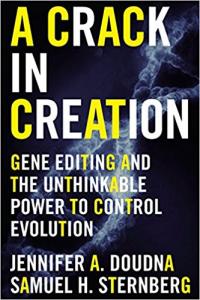Have you been following the breaking news about the revolutionary new gene-editing technology CRISPR? Not “crisper” with an “e”—like a refrigerator drawer for keeping your lettuce fresh—but the acronym for Clustered Regularly Interspaced Short Palindromic Repeats. (That clears it up, right?! No worries. More clarity forthcoming.)
Consider these headlines in The New York Times from just the past six weeks. The first headline is from July 27: “In U.S. First, Scientists Edit Genes of Human Embryos.” It says “In U.S. First” because Chinese scientists were the first to experiment with this breakthrough two years ago in mid-2015 (xix). That highlights a crucial factor in bioethical debates: not only should something be tried, but also, what happens if others move forward and we do not? The headline continues, “Scientists Edit Genes of Human Embryos,” but it is important to add that “the embryos were not allowed to develop for more than a few days and were never intended to be implanted into a womb.” In other words, we are currently holding ourselves back. Perhaps rightly so, but it depends on whom you ask.
The second headline is from August 30: “F.D.A. Approves First Gene-Altering Leukemia Treatment, Costing $475,000.” The U.S. Food and Drug Administration has “approved the first-ever treatment that genetically alters a patient’s own cells to fight cancer, a milestone that is expected to transform treatment in the coming years.” This particular treatment is for an especially aggressive type of leukemia, but many similar gene therapies are in the pipeline. The half million dollar price tag is because a single-dose must be tailored for each individual, which can make the treatment both effective and expensive. “The first child to receive the therapy was Emily Whitehead, who was 6 and near death from leukemia in 2012 when she was treated…. Now 12, she has been free of leukemia for more than five years.” Such possibilities open a whole new world beyond today’s typical regimen of “surgery, radiation, and chemotherapy” (175). Additionally, two days ago, the below-the-fold cover story was “New Gene-Therapy Treatments Will Carry Whopping Price Tags.”
 A helpful guide to this cutting-edge world of possibilities is a book titled A Crack in Creation: Gene Editing and the Unthinkable Power to Control Evolution by Jennifer Doudna and Samuel Sternberg (Houghton Mifflin Harcourt, 2017). To name one among her many appointments, Doudna is a professor in the Chemistry and the Molecular and Cell Biology Departments at the University of California, Berkeley. Sternberg is a fellow researcher and doctoral-level biochemist.
A helpful guide to this cutting-edge world of possibilities is a book titled A Crack in Creation: Gene Editing and the Unthinkable Power to Control Evolution by Jennifer Doudna and Samuel Sternberg (Houghton Mifflin Harcourt, 2017). To name one among her many appointments, Doudna is a professor in the Chemistry and the Molecular and Cell Biology Departments at the University of California, Berkeley. Sternberg is a fellow researcher and doctoral-level biochemist.
While I mainly want to focus on the technology and its potential implications, I can’t resist sharing the story that first launched Dr. Doudna on a trajectory toward become an expert on genome engineering. When she was twelve, she returned home from school to find on her bed a “tattered copy of James Watson’s The Double Helix”:
My dad would occasionally pick up books for me at used bookstores to see if they sparked any interest. Thinking this book was a detective novel —which it was!—I set it aside for some weeks before diving into its pages one rainy Saturday afternoon…. I felt the first tugs of interest that would eventually guide me onto a similar path. (10)
I love that story. I find it fascinating to trace the difficult-to-predict sparks that can grow into a lifelong passion. And that passion for discovery, ignited by reading about the mid-twentieth-century discovery of DNA’s molecular structure, led to the innovation of CRISPR.
But perhaps appropriately for an invention whose full implications are far from clear, neither of these scientists set out to turn biotechnology and bioethics on their respective heads. Rather, their intention was to research “the way that bacteria defend themselves against viral infection.” In so doing, they stumbled backward into the “workings of an incredible molecular machine that could slice apart viral DNA with exquisite precision. The utility of this same machine to perform DNA manipulations in other kinds of cells, including human cells, was immediately clear” (xvii).
It is at this point that bioethicists diverge. In politics, the saying goes that, “One person’s terrorist is another person’s freedom fighter.” Likewise, in bioethics, one person’s sacrilege is another person’s sacred responsibility (xviii):
Some people view any form of genetic manipulation as heinous, a perverse violation of the sacred laws of nature and the dignity of life. Others see the genome simply as software—something we can fix, clean, update, and upgrade—and argue that leaving humans beings at the mercy of faulty genetics is not only irrational, but immoral. Considerations like these have led some to call for an outright ban on editing the genomes of unborn humans, and others to call for scientists to forge ahead without restraint.
One side argues that we must beware the “Law of Unintended Consequences.” The other side urges that, “Someday we may consider it unethical not to use germline editing to alleviate human suffering” (xix).
Speculation aside, let me tell you about what has already happened—because a few newspaper headlines notwithstanding, it seems evident that scientific research is significantly outpacing public awareness of bioethical breakthroughs (200-201):
-
Scientists have harnessed CRISPR to generate a genetically enhanced version of the beagle, creating dogs with Schwarzenegger-like super-muscular physiques by making single-letter DNA changes to a gene that controls muscle formation.
-
In another case, by inactivating a gene in the pig genome that responds to growth hormone, researchers have created micro-pigs, swine no bigger than large cats, which can be sold as pets….
-
Meanwhile in the plant world…gene-editing experiments have produced disease-resistant rice, tomatoes that ripen more slowly, and soybeans with healthier polyunsaturated fat content….by fine-tuned genetic upgrades involving changes to just a few letters of the organism’s own DNA….
-
In recent experiments, CRISPR has been used to “humanize” the DNA of pigs, giving rise to hopes that these animals might someday serve as organ donors for humans….
-
In laboratory-grown human cells, this new gene-editing technology was used to correct the mutations responsible for cystic fibrosis and sickle cell disease, among many other disorders. (xiv-xv)
So much more is quickly becoming possible—or is already possible—that we’re not yet sure, collectively, whether it’s a good idea to try. Some of you will recall the tale of Prometheus: “the deity in Greek mythology who was the creator of humanity and its greatest benefactor, who stole fire from Mount Olympus and gave it to humankind.” With CRISPR, we are playing with fire with great potential for promise and peril.
I will continue this theme in tomorrow’s post on “Revolutionary Bioethics: from “Gene-editing” to “Genome Engineering.”
Learn more about Unitarian Universalism: http://www.uua.org/beliefs/principles
















